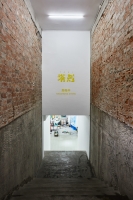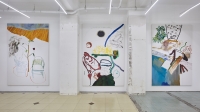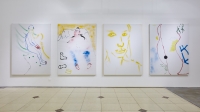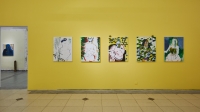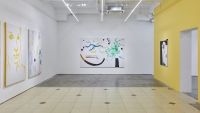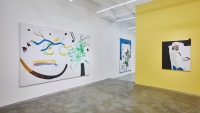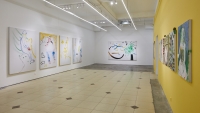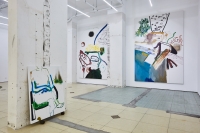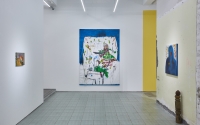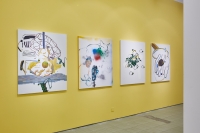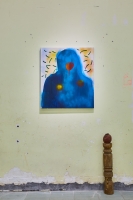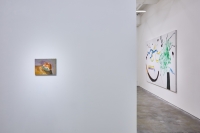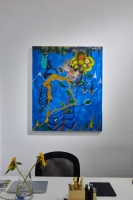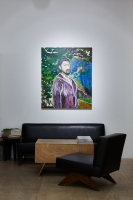郑皓中个展:塔剋
2019.05.26 - 2019.07.31
TAKI 作为艺术家简单的社交生活结构中重要一员,特殊的身份却让社会属性愈加模糊。
继个展"李察(Lee Cha)"之后,郑皓中在BANK的第二次个展"塔剋(TAKI)"随即见面。在郑皓中(李察)小说作者般的工作里,'邱晨'与'漫游者'竟是艺术家长期考察的田野。艺术家考察的这两个特殊状态的人,这两个游离于社会结构之外的人,正如考察社会意识的边缘。他们不愿意被社会的价值标准捕获,然而肉身的生活又无法完全脱离人类社会而生存,因此只能时时在悖论中努力与社会的边缘达成微妙的脆弱的平衡。这显然指向一种自由。艺术家借由描绘对象,而画面中显现出另外两个参与角逐的力量,社会,以及作为观察者的艺术家。
TAKI是郑皓中生活中的伴侣,她看似接替了其现实世界的媒介,但实际上,由于TAKI与艺术家生活是重叠的,部分去除了原先艺术家画面中的观察对象,那个努力独立的“人”的存在。就像加缪的《局外人》,近乎一种“零度写作”,他那些看似不相关没有逻辑联系的事件与画面的到来,是一种中性的白色的写作方式。郑皓中画的是一种社会留白,实际上更加缺席了半个人,使艺术家自身投射物的比例相对增加。他常以无法预计的跨度去完成一幅或多幅绘画,仿佛是世道的奔波,或不固定的时间,导致绘画中的人在不停移动。这种更加留白的观察方式,已经默许为郑皓中自身与社会抵达某种平衡的方式。规则之外的平衡将如何展现?这些画面—“缺席的人"正指向社会的负形态与艺术家之外,缺席而留下的真空。恰是这种真空,才能更多的把自身的真实状态裸露出来。
Haozhong Zheng solo show: TAKI
2019.05.26 - 2019.07.31
TAKI is an important figure in the artist’s simple social life structure. However, her somewhat unique identity, in a way, blurs her social property.
TAKI, Zheng Haozhong’s second solo at BANK, follows, Lee Cha in2016. Lee Cha, (the artist’s penname) works as a novelist and painter, whereby “Qiu Chen” and “the wanderer” were subjects of his long-term field research and observations. Here the artist studies two people who were in a particular state as socially marginalized individuals. The observation upon them presents a chance to investigate the edges of social consciousness. On one hand, they don’t want to become the captive of standard social values; but on the other, it’s impossible for them to completely detach their bodies as well as their life from human society. As a result, they constantly endeavor to reach a subtle yet fragile balance within the edge of society. Apparently, the appeal for freedom could be sensed from within. While the artist depicts his subjects, there are two other forces emerging from within the image –society and the artist as observer.
TAKI is a partner in Zheng Haozhong’s life. On the surface, it seems that she takes the role as a visible medium to present the world Zheng sees. But in fact, as the life of TAKI and that of the artist are overlapped, the objects of observation in the artist’s images – the presence of “man” striving to become independent – is partially erased. Like Camus’ The Stranger, he resorts to a similar approach of “zero writing”, introducing seemingly irrelevant and illogical events into the image, forming a kind of neutral writing with blankness. What Zheng Haozhong delineates is societal blankness, accentuating the missing half of a human figure while enhancing the proportion of the artist’s own projection. He often completes multiple pieces of painting works simultaneously in an unpredictable manner, imbuing his work with a sense of fluctuation or of fluid time, resulting in the constant movement of human figures in his work. Such observations with massive space for blankness have been taken as a means for Zheng Haozhong to reach a kind of balance with society. How to represent the balance beyond rules? These images – the absent men – point directly beyond the negative form of society as well as the artist; in other words, the vacuum caused by the absence. It is thanks to such a vacuum that pure truth finds a way to be exposed.
